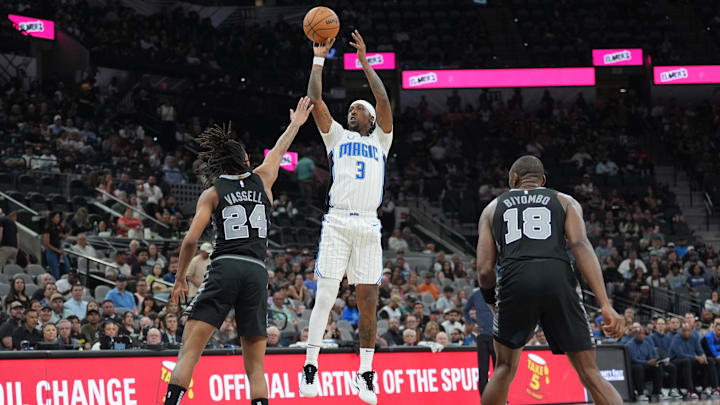The Orlando Magic are rightfully hungry to make some meaningful improvements this offseason. Everybody is expecting the team to make some major changes, and the media is even hinting that the Magic have been active in the trade market to find a guard to help boost the team.
Undoubtedly, the Magic must improve their offense after ranking 27th in offensive rating last year. Ultimately, the Magic desperately need more shooting after finishing last in the league in 3-point field goal percentage.
There are no quick fixes. After all, Kentavious Caldwell-Pope was supposed to help with a lot of the team's shooting issues and struggled to find his footing this year. The Magic's shooting issues are tied as much to their lack of playmaking and creation as anything else.
The poor shooting weighed on everyone and dragged the team down.
"I feel like mentally, when things aren't going your way, it always takes a mental toll on anyone," Wendell Carter said during exit interviews. "I think that definitely played a part in it. And that kind of affected our confidence."
But even in a relatively bleak season, there are some signs the Magic were getting the right kinds of shots. There were signs the Magic's shooting infrastructure was not so bleak. . . they just missed.
Orlando had a 3-point shooting problem long before the 2025 season began.
A lot of it was that the Magic were not taking enough threes after they finished 29th in the league with 31.2 3-point attempts per game during the 2024 season. They were 24th, making 35.2 percent of their threes. As Jeff Weltman liked to point out, Orlando went to 19th at 35.8 percent from three after the All-Star Break.
None of that carried over, of course. The Magic were last in the league, shooting 31.8 percent during the 2025 season.
Despite trying to take more attempts, at 35.3 per game (23rd in the league), the poor percentage ultimately led the Magic to be far more selective shooting from three because of how inefficient that shot became.
Orlando though was still looking to get threes. It was still about taking better 3-pointers. There was sense in the process.
"I think it was an issue that got resolved at times," Gary Harris said during exit interviews. "Going back and looking at the film, looking at the different play styles and ways to get more shots, and shots where people are comfortable, and a good flow to get the actual amount of shots up. It's definitely a shooting issue, but when you don't have that many chances and that many shots, it can be tough for shooters to catch a rhythm for sure."
Increasing the team's volume was key to improving the team's shooting. But there were plenty of numbers that suggested the Magic were getting more quality looks.
Last year, Orlando ended up shooting 18.8 "wide-open 3-pointers per game (where the closest defender was 6+ feet away) according to NBA.com's tracking stats. They made 35.1 percent of these shots, ranking 17th in attempts and last in percentage.
Orlando averaged 9.8 corner threes per game, 14th most in the league. They made only 35.4 percent of these shots -- 28th in the league.
This compares to shooting 18.2 "wide-open" threes per game and making 37.8 percent of them last year, around the league's median, and 8.5 corner threes per game at 36.7 percent last year.
By those numbers, the Magic improved the quality of their 3-point looks, they just missed them.
Even in the Playoffs, Orlando still managed 18.0 "wide-open" threes per game. The Magic just made only 28.9 percent of those shots.
The problem for the Magic is not the quality of the shots they are getting. Objectively, the Magic got more quality shots this season compared to last season. The problem is that the team is not making them.
"You talk about the numbers of what our shooting was," coach Jamahl Mosley said during exit interviews. "It wasn't expected to be that. That's the reality of where we are. I think it comes down to what we do this summer and how we work. It's not just what we bring, it's also the guys in here improving and getting better at their craft. We'll make it an emphasis. We'll make it a focus. But it's also how do we continue to get these guys better as we see the jump and improvement from each of these guys."
In many respects, the Magic accomplished their goal of getting more quality 3-point looks.
If Orlando applies that process with better shooting, then it should lead to better outcomes. And who knows what else that will open up for this team?
The question is how to fix this issue.
Injuries were part of the problem. The team lacked much rhythm, and there were a lot of periods where the team was working to get players back into the lineup. Jeff Weltman noted the team's internal metrics suggested the team's shot quality varied wildly depending on how healthy the team was at any given time.
It is no coincidence that the Magic's best stretch of shooting -- 36.2 percent shooting and 35.2 attempts per game after March 8 during the team's 12-6 run to finish the season -- came when they were healthiest.
It all suggests the Magic's problems are really that simple: They could not make enough shots to take advantage of advances in their offense. There were positive signs from the team.
The Magic are undoubtedly focusing on their offense this offseason. The team must make those improvements.
Acquiring better shooting is at the heart of that. But the Magic's process to find good shots was not necessarily the problem.
And that is a good sign for the team moving forward.
